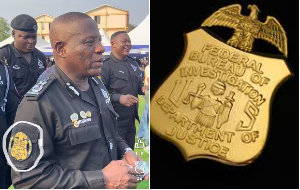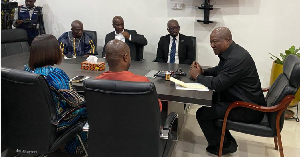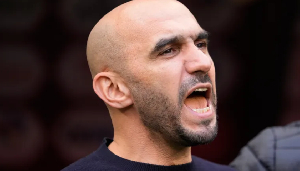Awodada or Regent?
I will be most obliged if you can give me a space in your paper to re-act to an article published on pages 2 and 7 of the CHRONICLE, Tuesday, June 8, 2004 captioned as above. (READ)Certainly, the Awadada Togbi Agbesi Awusu II is the one ruling Anlo in the interim until a new Awomefia is installed and proclaimed. This is no news and any matured Anlo knows it. As proof of the above statement, I say as follows:
1.The author of the article Mr. Emmanuel Ashiagbor of the Keta Youth and Development Association claimed to have conducted a diligent search into Anlo heritage and have discovered that the Awadada is after all not a chief. He further claimed that the alleged self-styled Regent Togbi Sri Ill has been inducted and accepted by the Anlo Traditional Council and inferred that it is he who must rule Anlo in the interim.
2. He further asserted that: the Awadada is not a Chief because the chieftaincy Act and the procedure laid down for installing chiefs in Anlo do not cover his position, nor make provision for him. If we disregard the long rigmarole about chieftaincy rituals, fetish priests and the strategy of the Awadadawo in battle, which were obviously calculated, to ridicule the Awadada's position, it is obvious that the issue raised by Mr. Emmanuel Ashiagbor is a matter concerning chieftaincy. The chieftaincy Act, 1971 Act 370 is therefore the only appropriate authority under which the issue could meaningfully and seriously be discussed.
3. Section 16, Sub-section 2 of part Ill of the Act, under the heading "Traditional Councils", which deals with meetings of a Traditional Council; stated "where the president is from any cause unable to attend a meeting, the chief next in seniority on the council shall preside over the meeting" .
4. Section 48 Sub-section 1 part vm of the same Act; under the heading, "who is a chief" defines a chief as "An individual who has, in accordance with customary law, been nominated, elected and installed as a chief or as the case may be appointed and installed as such and whose name for the time being appears as a chief on the National Register of Chiefs."
5. The question is whether the Awadada is qualified as a chief under the provisions of the Act? The answer is unequivocally in the affirmative. The Awadada has been nominated elected and installed as a chief on the Kak1aku Stool of Anlo on September 17, 2000 at Anloga, as Togbi Agbesi Awusu II, the 14* Awadada of Anlo, in accordance with Anlo Custom and Tradition. His name is entered in the National Register of Chiefs as, Serial No. 2451
as a chief from Anlo in the Volta Region. As a matter of fact, the present Awadada up till now, has chaired various public functions as the Acting President of the Anlo Traditional Council, where the present Honourable Regional Minister and H.E. the President of the Republic of Ghana himself and H.E. the vice President and also H.E. the Ex-President of Ghana were Guests of honour without complain.
6. The next question is whether the Awadada is next in command to the Awoamefia of Anlo. The answer to this question is again in the affirmative. The first official list of all the chiefs of Anlo appeared in the report of the Commission of Enquiry into the affairs of the Anlo State by a committee appointed by the colonial Government in 1912 chaired by Mr. Francis Crowther. In that list and in subsequent, 1935 and 1945 lists of Gold Coast chiefs and the current one, the Awadada's name appears at the top of the Anlo chiefs, 2nd only to that of the Awoamefia.
7. It is trite to say that the Awadada Togbi Agbesi Awusu II's predecessors on the Kaklaku stool have acted as Awoamefias in the past. For example after the death of Togbi Amedor Kpegla the Awoamefia on February 9, 1906 till the enstoolment and the installation of Togbi Sri II as the Awoamefia, it was the Awadada, Togbi Kugbeagbo Katsriku who acted as "Fia" (Le. the Awoamefia) as tradition demanded; he played a vital role in the installation ofTogbi Sri II and held the fort for him for the period of six months while he was on leave of absence to round up his affairs in the Cameroon, before assuming duty as Awoamefia.
8. The Awadadawo who followed Togbi Kugbeagbo Katsriku also played the acting role for the Awoamefia whenever the need arose. It is pertinent here to state that in a tribute to the memory of the late Awadada Axorlu II from the Anlo Traditional Council by Togbi Addo VIII, Fiaga of Klikor and published on page 13 paragraph 6 of the funeral brochure, the Council stated that "Awadada Axorlu II the two LC. to the Awoamefia could have revived our hope and fortitude had he not been taken ill just about the time his boss was bed-ridden". This was an acknowledgement by the Traditional Council through Togbi Addo VIII of the Awadada's position among the Anlo Chiefs.
9. Again on page 14, in paragraph 1, of the same brochure Togbi Addo VIII stated on a more personal note that "When I was brought to the Anlo Traditional Council on 4th March 1983 to be recognized as the Fiaga of Klikor. It was he who received me and handed me over to the Awoamefia because he and I belonged to the Adotri Division of the Anlo War formation". This again is an admission that the Awadada belongs to a higher echelon of Anlo Chiefs.
10. In June 2001 in another tribute, this time to Togbui Nyaho Tamakloe IV, Miafiaga of Anlo from the Anlo Traditional Council and read by Togbi Addo VIII Fiaga of Klikor the Anlo Traditional Council recognised the position of the Awadada on page 21 paragraph 1 of the funeral brochure as follows. "The call to eternity of his two protagonists of the Woe and Adotri Divisions, namely Togbi Gbordzor and the Awadada, Togbui Axorlu II, respectively, and above all, our late Awaomefia, Togbui Adeladza II has left a wound on the council that would have taken many years to heal. The results of these sad events led to Togbui Nyaho Tamakole IV's assumption of the Presidency of the Anlo Traditional Council until the installation of Togbui Agbesi Awusu II as Awadada of Anlo, late last year". It is to be noted that during these times, when the Awoamefia, the Awadada and Togbi Gbordzor were absent from Traditional Council meetings leaving Togbi Tamakole IV the most senior chief after the three chiefs listed above to take over the Presidency of the Traditional Council, Togbi Addo VIII was the Head of the then Awoamefia Secretariat and also the Vice Chairman of the Standing Committee of the Anlo Traditional Council; his pronouncements were therefore very authoritative.
11. I also wish to refer Mr. Emmanuel Ashiagbor and his research team to the District Record Book 1900-1927 on the Anlo Ewes, File ADM 41/5/6 at the Public Records and Archives Administration Department, Accra. In these records under the heading AWUNA CLANS is listed the names of the 14 Clans which constitute the Awuna in their order of seniority, their places of origin and special functions. The Agave Clan is listed as No.6. The Clan's special functions are stated as follows "War Captains Stool Next in seniority to that of Fia. Can act when no Fia".
12. In May 1967, the Government of this country found it necessary to appoint a Committee of Enquiry to enquire into the affairs of the Anlo Traditional Area. They appointed three
distinguished Ghanaians namely Justice George L.A Djabanor, a retired High Court Judge, Nene Annorkwei the Paramount Chief of Prampram and Togbi Adja Tekpor VI, the Osie (Paramount Chief) of Avatime, both of whom were Presidents of their respective Regional House of Chiefs at the time. The committee received representations in writing from the general public, took oral evidence and studied documents to help their deliberations and submitted their report to the Government. On page 3 paragraph 9 of the report they stated; whiles writing on the installation of Togbi Adeladza II as follows: "According to the Awadada the most Senior Chief of Aulo whose constitutional position was likened to that of the British Premier, the installation was carried out according to custom and in compliance with the instructions contained in the Gazette Notice in that behalf." This is again recognition by these three august citizens of this country, who had the mandate to enquire into the Affairs of the Anlo Traditional Area, of the position of the Awadada as a Chief and a powerful one as such in Anlo.
13. It is therefore surprising that the "exhaustive search" by young Mr. Emmanuel Ashiagbor and his equally young colleagues of the Keta Youth and Development Association did not lead them to any of the documents referred to above especially the portion of the Djabanor Report which was published in part in your paper, the CHRONICLE, of Monday October 6, 2003. Instead they decided to mislead themselves and the un-informed by relying on undisclosed sources of information and fictitious Royal Adjovia archives
14. Also in the proclamation on the restructuring of Anlo Wings from Military Basis to Civil Division Ref. ATC/C.INOL.8/183 dated 4th February, 1991 and signed by the late Togbi Adeladza II, Awomefia of Anlo, it is stated in paragraph 12 that "the Awadada therefore becomes and is the 2- in command to the Awoamefia and he acts in the absence of the Awoamefia". This is the latest edict and whether we like it or not or criticise it or not, until it is changed, it stands as our regulation or law and ought to be obeyed.
15. In the light of the documentary evidence listed above there is no valid reason why the position of Togbui Agbesi Awusu II, the 14th Awadada of the Anlo, as the second most Senior Chief of Anlo, and the rights and the responsibilities that go with it should be questioned at all. He sits on the stool, which is the most senior stool in Anlo, next only to that of the Awoamezi
16. Section 16, sub-section 2, part III of chieftaincy Act, 1971; Act 370 gave him the right to rule Anlo in the interim, that is until an Awomefia in stalled in succession to Togbui Adeledza II.
17. Turning to the position of the "Regent" I would want to say that the Anlo Constitution does not make any provision for a Regent for the Awoamezi. The only occasion in Anlo history that mention was made of Regent Awoamefia is in the case of Togbi Atiasa, who declared himself Regent Awoamefia on the death of his brother, Togbi Atia after a short reign. He then managed to get himself installed as Awoamefia that is, usurping the throne after his brother, thus blocking the chance of the Bate Clan whose turn it was. This happened at a time when there was no Awadada sitting on the Kaklaku Stool.
His action created a confusion and disruption to the hither to smooth succession between the Adzovia and the Bate Clans to the stool and lead to retaliation by the Bate Clan and an attempt to deny succession to the Adzovia Clan, Togbi Atiasa's action was declared wrong at the 1906 settlement between the Adzorvia and the Bate CLans, and so paved the way for the installation of Togbi Sri II.
18. Sub-section 2 of section 16 of Act 370 did not mandate the Traditional Council to elect or appoint any person other than "the Chief next in Seniority" to the absent President to preside over the meeting let .alone someone who is not claiming to be a chief, and whose claim of being Regent is even being challenged before the Judicial Committee of the Volta Regional House of Chiefs.
19. These records should be enough to prove to any open-minded person that the Awadada of Anlo is next to the Awoamefia in seniority with the right to act as "Fia" when there is no Awoamefia and to rule Anlo until a new "Fia" is installed.
Perhaps Mr. Emmanuel Ashiagbor and his team can make public the information obtained in the course of the "search" and their sources, which led them to the conclusions they have reached. It will also be most interesting to know what those "golden letters" from the "Adzorvia Royal Archives" say and where on earth they are to be found.
20. As a matter of public interest and education, the Anlowo formerly Dobogoawo brought with them from Tado to Nostie and to Anlo only two stools, the Kaklaku, that is, the stool of the Awadada and the Awoamezi which was left behind at Notsie during the exodus from that place but later retrieved through the bravery and ingenuity of the legendary Amesimeku Nyatsikor alias Torgolo assisted by his junior cousin Tsatsu Adeladza. All other stools were created in their new settlement here.
Also it is only the Awadada's Agbotadua who is installed as a real Chief and he too has his own Agbotadua. Further more it is the Awadada who created the war stools or stools of valour, and most Anlo Chiefs occupy stools of val our.
I have never heard that the current Awadada had ever claimed that he is entitled to ascend to the Awoamezi: what he is claiming is that according to the Anlo constitution. in the event of the
death of the Awoamefia.. it is the Awadada who takes care of the vacuum so created. and sees to it that one of the two clans Adzovia or Bate, whose turn it is to select a suitable candidate for the enstoolment and installation as its Awoamefia. does so and then he sees to it that the Awoamefia elect is enstooled and installed before he hands over to the new Awoamefia.
This is in conformity with a document submitted by the Chiefs of the Adjovia Clan of Anlo in May, 1906 and quoted by the Djabanor report which states that" A man of good reputation is appointed by the tribe (clan) that is to succeed to the Fia (Awomefia) stool. This man is presented to Amega next (to) Fia or Acting Fia, any man occupying the stool of Katsriku". In other words the "Kaklaku Stool".
21. The transitional arrangement may seem strange to the youths who do not understand why the Adzovia and the Bate should sit down for an Awadada from the Agave Clan to interfere with their "rights". But there is wisdom in the system because, those who are familiar with the Anlo chieftaincy history very well know that the succession to the throne did not follow the one to one alternation between the Adzovia and the Bate with its attendant problems, hence the necessity for a neutral person who has no right and of course no ambition to the throne, to act as Fia during the change over. The Kofi Dzotefe/Togbi Sri II's case of 1906 and the S/Sgt Dedzo as he then was Togbi Adeladza II's case of 1956, and even the present confusion about a successor amongst the Adzoviawo themselves and compounded by the unnecessary problem of a Regent are, indications of the need for a high powered neutral Chief to be involved in the process.
22. The comparison that Mr. Ashiagbor made between the Awadada and Togbi Naza of Alakple is not only amusing and misleading but also not tenable because the two persons are performing different functions. While the Awadada is occupying a stool as a chief, Togbi Naza is a divine priest or Tronua to the Divinity Togbe Nyigbla and his functions are purely spiritual. Kaklaku, the Awadada stool with the Adzoyi and the Azadagli as its icons, or if you like, its regalia is not a Tro or divinity and the Awadada is not a tronua or a divine priest. His white garb is a symbol of his readiness to die for the Anlo State in battle and be buried wrapped in white cloth anywhere and at anytime. The white garb does not mean that he is a divine priest. Togbe Nyigbla is a divinity and even though. it is the war divinity or war god, its head does not go to the battlefront. He stays behind to continue the sacrifices, the rituals and the invocations of the divinity, in short to offer prayers, unlike the Awadada who is the Supreme Commander of the armed forces and therefore completely involved in the total control and direction of the battle and of course the war. It is just ignorance and naivety to suppose that the military headquarters is located in the battlefront.
Yes it true that the enstoolment of Awadada is different from that of other Chiefs and that of the Awoamefia. But what is not true is that, because the Loafe and the Amlade clans do not take part as claimed by Mr. Ashiagbor, the rituals do not make the Awadada a Chief, but rather a divine priest. The truth is that the two clans Loafe and Amlade take part, but play slightly different roles as compared with the roles they play in the installation of an Awoamefia and other Chiefs. Other clans, as the Like Clan who are the descendants of Amesimeku Nyatsikor alias Torgolo who served as the protector and personal advisor to the Awadada, and the Agave clan to which all the Awadadawo belong, and who also are the descendants of Agor the man who brought the Kaklaku stool to Anloga, rather play prominent roles. These are the peculiarities that make the Awadada's installation and position in Anlo unique.
23. It is therefore clear and rather sad from the above facts that, the disrespectful words and phrases such as:
- "dastardly and unschorlary behaviour the Awadada put up"
- "the role of a divisional chief he proclaims to perform is a hallucination"
"he is a liability to the state and should stop projecting himself as a chief. "The President of Anlo Traditional Council he conferred on himself is a display of neurosis"
and many more used on the Awadada are uncalled for and therefore demands an immediate and unqualified apology to his person, the Agave clan, as well as to the Chieftaincy Institution of Anlo and to the Anlo State in general.
Thank you
AMEAMU GAKLEAZI
P.O. Box 3048 Accra.
Tel. 022401046














